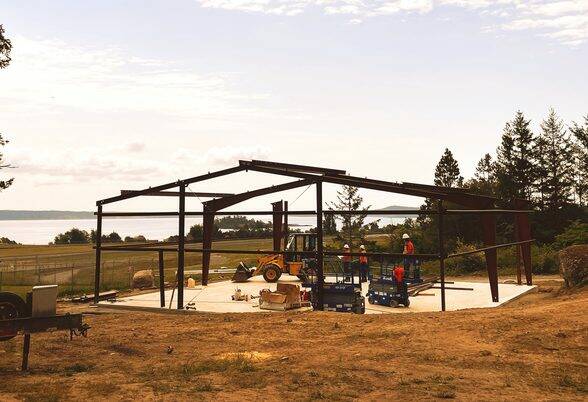By Kathryn Wheeler, Journal contributor.
This past May, the Island’s Oil Spill Association began raising the walls of their new headquarters. The large warehouse, first conceptualized four years ago, will expand the potential of the organization that has been the islands’ oil spill volunteer, first responders, since 1985.
“The organization is on really solid long-term footing, which is great,” said Brendan Cowan, the IOSA Board Treasurer and Director of the San Juan County Emergency Management. “The headquarters is the tangible hub for all of that.”
The building was born out of a partnership with the Port of Friday Harbor, where the IOSA will build and lease the space for their headquarters. According to Cowan, the structure will be by the airport, near Skagit Valley College. The organization’s website states that “the building will contain office space, a classroom, and a flexible design that allows for the front wall to fully open to the outside in the event the space needs to be used for response operation or hands-on training.” Funding for the project was secured this past year, with contributions from The Port of Friday Harbor, the state of Washington, and a capital funding program.
Since its inception by a group of concerned citizens nearly 40 years ago, IOSA stored its valuable equipment in hard-to-move trailers parked on soggy ground, with only a small office space to gather its team and conduct training.
To Cowan, this new building is more than just a storage hub. The headquarters marks a new existence for IOSA, he says, and a future that is finally secured after a years-long struggle of redefinition. Beyond the long search for a new executive director in recent years that left the organization in flux, IOSA has come to see their role on the islands as changing. Formerly the primary response contractors for oil spills, IOSA has passed that duty on to US ecology and tow boat US in recent years, recognizing the need for more resources in response to the increasing threats of large oil spills.
The organization remains unique among national oil response teams due to its powerful volunteer base that once almost entirely handled island oil spills. But as it has recognized a need for help and partnership, its role has evolved into a training center, and harborer of equipment that can be deployed when the inevitable oil spills come. “We’ll have a command post headquarters inside, with partners working on a response,” said Cowan, who is excited for the potential of extensive collaboration with many partners.
This may in fact be critical for the islands’ survival. With the expansion of Canada’s Trans Mountain Pipeline bottoming out in British Columbia, oil spills may become more frequent and more dangerous, due to the sheer amount of oil being carried on the water. According to the 2021 Salish Sea Vessel Traffic Projections published by the Friends of the San Juan Islands, increased oil infrastructure will bring a projected 25% increase in vessel traffic across the Salish Sea.
With these looming threats, IOSA continues to work quickly to erect the building, hoping to complete the project this coming fall. There is “lots of good energy at the moment,” said Cowan. “We have improved capabilities and new capabilities that we never dreamed of happening before.” As the construction of the building marks the reconstruction of an organization, both provide greater stability in an inevitably uncertain future.



